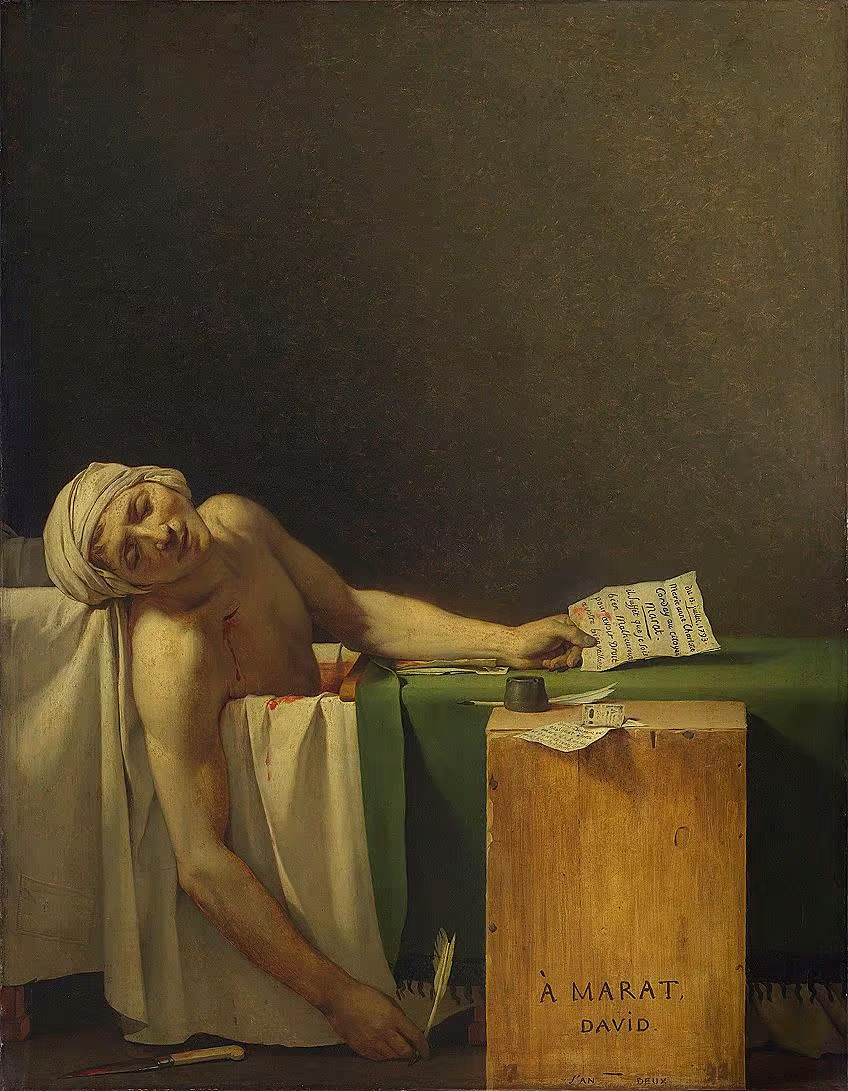Classical Era - Revolution and Art
The 1700s was a significant era marked by political and social movements that profoundly influenced the histories of both America and Europe. The struggle for independence and liberty during the American Revolution paved the way for self-governance, which in turn inspired the French to seek social equality during the French Revolution. The French established a republic founded on Enlightenment principles, which emphasized the intellect and reason of the human mind. These evolving social and political values were reflected in the artwork of the time. Artists emerged, creating pieces that captured the shifts towards human rights and democracy, moving away from the traditional focus on religion and mythology. They utilized their art to promote critical thinking about the ongoing revolutions. This new artistic movement that dominated the 18th century is known as Neoclassicism.

“The Death of Marat” (1793) by Jaques-Louis David in Paris, France
Neoclassical art is characterized by its inspiration from the art and culture of ancient Greece and Rome, focusing on heroes and their heroic deeds during the Revolutions. As Professor Kljaich noted in her lecture, "The paintings tended to be quite somber and very linear." During this revolutionary period, artists such as Jacques-Louis David drew from the ideals of these ancient democracies to visually embody the revolutionary ideas of their time. In his painting “The Death of Marat” (1793), David portrays the revolutionary leader Jean-Paul Marat as a hero in the struggle for liberty.
In this work, Marat is depicted with a low-hanging arm and blood splatters around him. The use of dark colors in the background creates an empty atmosphere, which directs the viewer's focus to Marat, who is painted in lighter tones, reminiscent of a light source illuminating his form. This choice evokes a sense of somberness as we reflect on the hero's death amidst the Revolution. David adheres to the Neoclassical theme of naturalistic composition (du Plessis) by representing Marat’s body in a realistic manner, reinforcing the historical authenticity of Marat’s role in the Revolution. However, Marat’s face is rendered to appear almost serene, as if he is peacefully asleep rather than being brutally assassinated. This idealized portrayal underscores David’s depiction of Marat as a martyr.

Declaration of the Independence” (1818) by John Trumbull in New Haven, Connecticut
Another painting that captures the historical significance of the Revolutionary period is John Trumbull's "Declaration of Independence" (1818). Trumbull employs a Neoclassical approach, characterized by careful symmetry and order in the arrangement of figures. He thoughtfully positions the Founding Fathers in a clear composition that illustrates the orderly manner in which they approached the signing of Independence. This emphasis on logic and reason reflects Enlightenment values. Additionally, Trumbull evokes connections to Ancient Greece and Rome by incorporating classical columns and arches into the setting, highlighting their democratic ideals.
In the painting, the figures are brightly illuminated, becoming the focal point, while the surrounding background remains shadowed. This spotlight effect emphasizes the unity of the Founding Fathers in their pursuit of Independence. In contrast to David’s "The Death of Marat," Trumbull's work inspires a sense of pride and patriotism. Personally, I would prefer to display this painting in my home, where it can evoke feelings of pride rather than the sorrow conveyed in David’s piece.

Emmanuel Leutze's "Washington Crossing the Delaware" (1851) Düsseldorf, Germany
Artists of the American Revolution often focused on the heroes of that era. Emmanuel Leutze's "Washington Crossing the Delaware" (1851) exemplifies this emphasis. In this painting, Leutze depicts George Washington crossing the Delaware River in 1776, during the Battle of Trenton. This artwork serves as a powerful representation of the American Revolution, showcasing Washington’s leadership and determination during a pivotal moment. Leutze employs muted colors to make the red in the flag stand out, suggesting that he aimed to evoke a sense of patriotism in the viewers. The depth of the figures is enhanced through the artist’s use of lighting and shadow (Emanuel Leutze's Symbolic Scene of Washington Crossing the Delaware, 2012). The painting holds significant historical importance in the narrative of American independence. While I’m unsure if I would hang this piece in my home, I would definitely display it in a classroom setting, as it would undoubtedly spark meaningful discussions about the era.
Works Cited
du Plessis, Alicia. “‘The Death of Marat’ by Jacques-Louis David - in-Depth Analysis.” Art in Context, 30 Aug. 2023, artincontext.org/the-death-of-marat-by-jacques-louis-david/.
Emanuel Leutze’s symbolic scene of Washington Crossing the Delaware. NEH. (2012, December 3). https://edsitement.neh.gov/closer-readings/emanuel-leutzes-symbolic-scene-washington-crossing-delaware



Comments
Post a Comment